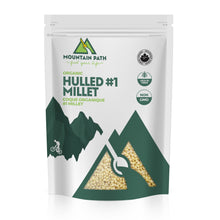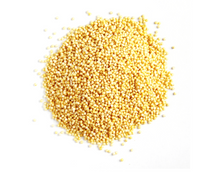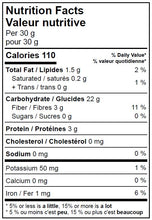Hulled millet is a small, round whole grain that has had its tough, inedible outer husk removed, making it ready for cooking. Millet (Panicum miliaceum) is one of the oldest cultivated grains, valued for its mild flavor, versatility, and impressive nutritional content. Hulled millet is gluten-free, easy to digest, and an excellent option for health-conscious diets.
Key Features of Hulled Millet
-
Appearance:
- Small, round, pale yellow seeds with a smooth texture.
-
Flavor:
- Mild, slightly nutty, and sweet, which pairs well with a variety of dishes.
-
Nutritional Profile:
- Rich in Complex Carbohydrates: Provides long-lasting energy.
- Good Source of Protein: Plant-based protein for vegetarians and vegans.
- High in Fiber: Supports digestive health.
- Micronutrients: Contains magnesium, phosphorus, manganese, and B vitamins.
- Gluten-Free: Naturally free from gluten, making it suitable for those with celiac disease or gluten sensitivity.
Health Benefits
-
Digestive Support:
- High fiber content promotes healthy digestion and regular bowel movements.
-
Heart Health:
- Magnesium and potassium help regulate blood pressure and improve heart health.
-
Blood Sugar Regulation:
- Complex carbohydrates and fiber help stabilize blood sugar levels.
-
Bone Health:
- Rich in phosphorus and magnesium, essential for maintaining strong bones.
-
Weight Management:
- Nutrient-dense and filling, millet helps curb hunger and supports healthy weight control.
-
Anti-Inflammatory Properties:
- Contains antioxidants that may reduce inflammation.
Culinary Uses of Hulled Millet
Hulled millet is a versatile grain that can be used in various dishes:
-
Breakfast Cereal:
- Cook as a porridge and top with fruits, nuts, and honey.
-
Side Dishes:
- Use as a substitute for rice or quinoa in pilafs and grain bowls.
-
Salads:
- Add cooked millet to cold salads with fresh vegetables and dressing.
-
Baking:
- Incorporate into bread, muffins, or pancakes for added texture and nutrition.
-
Soups and Stews:
- Use as a thickener or filler in soups and stews.
-
Veggie Burgers:
- Mix with beans and spices to form patties.
How to Cook Hulled Millet
Ingredients:
- 1 cup hulled millet
- 2 1/2 cups water or broth
- Pinch of salt (optional)
Instructions:
-
Rinse:
- Rinse the millet under cold water to remove any debris or bitterness.
-
Toast (Optional):
- Toast the millet in a dry skillet over medium heat for 2–3 minutes to enhance its nutty flavor.
-
Cook:
- Bring water or broth to a boil, add the millet, and reduce the heat to low.
- Cover and simmer for 20–25 minutes or until the liquid is absorbed.
-
Fluff:
- Remove from heat and fluff with a fork before serving.
Storage
-
Dry Millet:
- Store in an airtight container in a cool, dry place for up to a year.
-
Cooked Millet:
- Refrigerate in a sealed container for up to 5 days or freeze for longer storage.
Why Choose Hulled Millet?
-
Healthier Choice:
- Retains the bran and germ for maximum nutrition.
-
Gluten-Free:
- A safe and wholesome alternative for gluten-sensitive individuals.
-
Sustainable Crop:
- Millet requires less water and thrives in arid conditions, making it an eco-friendly choice.
Comparison to Other Grains
| Grain | Texture | Flavor | Nutritional Focus |
|---|---|---|---|
| Millet | Fluffy or creamy | Mild, nutty | High in magnesium, gluten-free |
| Quinoa | Slightly chewy | Earthy, slightly bitter | High in protein, all 9 amino acids |
| Rice | Soft and fluffy | Neutral | High in carbohydrates |
| Couscous | Light and fluffy | Mild | Low in fiber (refined) |
Hulled millet is a nutritious and versatile grain that works in a variety of recipes, from breakfast porridges to hearty dinners. Its mild flavor, easy preparation, and health benefits make it a valuable addition to any pantry, particularly for those seeking gluten-free or plant-based options.






